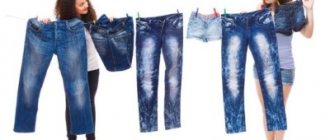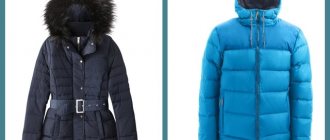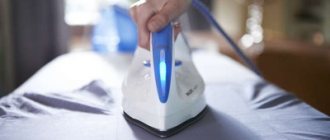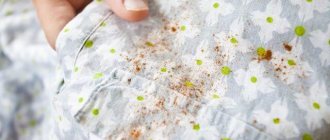When in the morning it turns out that the clothes washed the day before were not completely dry, and because of this the entire carefully thought-out image falls apart, do not rush to despair - everything can still be corrected. There are several proven simple ways to dry clothes quickly.
The easiest and best way to dry your clothes is to hang them up and let them dry naturally. If this tactic does not suit you, read this article
To dry clothes efficiently and quickly at home after washing or exposure to rain, use all possible heat sources: iron, hair dryer, radiators and even an oven. The main thing is to be careful and not to rush. Attempts to dry clothes very quickly, for example, over an open fire on a gas stove or on electric heaters, in which there is a risk of electric shock or short circuit, can result in damage to things and even a fire. How to properly, safely and quickly turn wet clothes into dry ones using homemade products and standard household appliances?
The weather often brings unpleasant surprises in the form of wet clothes.
Terry towels
The easiest way is to wrap wet items tightly in dry terry towels. To do this, a towel is spread on a horizontal surface, clothes are laid out on it and rolled into a tight roll. In order for the water to be absorbed faster, it is recommended to press down the resulting roll with your own weight, that is, sit on it for a while.
The towel method is considered the most suitable for drying woolen items, jeans, and items made from thin and delicate fabrics
If, upon unrolling the roll, it turns out that the terry cloth has become damp, but the item is still too wet, then you need to take another dry towel and repeat the procedure. An iron or hair dryer will help dry your clothes.
We bring to your attention a video where a man, using towels and an iron, dries a shirt in 6 minutes.
Using the oven
This drying method will take a little longer than the previous ones. Drying will take about an hour, sometimes more. You should proceed as follows:
- Hang the wet item on a hanger on the back of the chair.
- Preheat the oven and open the door.
- Place a chair next to the oven.
- Leave everything like this for an hour.
- Periodically, you need to turn your clothes over so that they dry evenly.
Important!
Be very careful, because the item may catch fire. Some people hang their clothes directly on the oven door. If you hang something very close to the oven or the door itself, it will absorb all the odors from the oven. And then you will smell not of pleasant perfume, but of baked chicken. It's unlikely that anyone will like it.
Washing machine
If your washing machine model has a drying mode, then it is most convenient to use it. It is important not to overdo it with the temperature - set it to the one recommended for the items and suitable for the types of fabrics from which they are made.
It is better to take things out slightly damp after drying in the machine, and then dry them with an iron
If you don't have a dryer in your washing machine, you can use the spin mode. Here it is also important to consider what maximum intensity of revolutions the fabric will withstand. Place several dry terry towels in the drum along with the wet items. They will effectively absorb excess moisture and help dry wet clothes significantly quickly. After this, the items are additionally ironed with a warm iron.
Iron
The most traditional method of drying wet clothes is ironing. At the same time, do not forget to turn off the steam mode on it.
When drying things with an iron, you don’t need to move it over the fabric - it’s better to lower the iron with the entire sole and press lightly for a few seconds, gradually moving it from place to place
It is better to iron wet fabric through a dry cotton rag or gauze, which absorbs water well from clothing and prevents the appearance of a shiny sheen that often occurs when ironing items made from dark fabrics. It is recommended to start drying with an iron with the densest multi-layered parts (belt, collar, cuffs); single-layered ones should be ironed on both sides. If things are too wet, don't try to dry them in one go. Just hang the ironed clothes on hangers and let them “catch their breath” for 10-15 minutes, and then iron them again.
Iron drying should not be used for wool and silk items.
Calculating the time
Knowing how to quickly dry things, you can easily calculate the time it takes to dry them. This will come in handy if you only have one pair of jeans or only a pair of socks left without holes. Drying clothes occurs in the process of removing moisture from the fibers of the fabric, so the drying speed will depend on five factors.
- Spin. The better you wring out the item, the faster it will dry.
- Material. Clothes made from natural materials dry more slowly than synthetic items, since silk, linen and cotton absorb moisture well. It also takes a lot of time for dense fabric to dry.
- Air circulation. Moisture from wet laundry will remain “hanging” near the dryer, preventing further evaporation. Therefore, it is important to create a draft: open a window, turn on the air conditioner or fan.
- Air temperature. High and low temperatures are almost equally effective in drying clothes quickly.
- Hanging density. On the dryer, hang bulky items on top, and small items on a lower level. Free space on the counter will help clothes dry faster.
Hair dryer and fan
Drying using a directed stream of hot air from a hairdryer or fan heater is one of the recommended safe methods for woolen items.
A hairdryer helps not only tidy up your head, but also quickly dry your clothes.
Clothes should be hung on hangers and, holding a hairdryer at a distance of 40-50 cm, direct hot air at them. During the drying process, the wet item must be rotated so that the airflow is uniform on all sides.
We offer you to watch a video where a person, using a floor fan, dries a T-shirt in 5 minutes.
What not to do
Due to the fact that often a wet item needs to be dried urgently, there may not be the best ideas on how to dry it. Therefore, the following drying methods are prohibited:
- open fire;
- electric heater.
Both methods are dangerous due to ignition of the fabric, which can lead to a fire.
A damaged item is far from the most dangerous consequence of drying things over an open fire.
Kitchen appliances
Non-standard solution: many advise using kitchen equipment - ovens and microwaves - to quickly dry clothes.
A slightly open oven ensures constant circulation of hot air in the room
It’s still better not to dry things inside the oven It is more correct and safer to place wet clothes on the back of a chair, which should be placed near the oven. If there is convection in the oven, it is recommended to turn on the fan, set the heating mode to low: 100-120 ℃, leave the door ajar. It is advisable to constantly turn and rehang things during the drying process.
If you decide to use the oven to quickly dry clothes, first wipe its bottom and walls from carbon deposits and residual grease.
A microwave as a drying equipment is only suitable for small items: socks, mittens, gloves. It is important that the inside of the oven is clean, otherwise the clothes will not only become dry, but also greasy and smell like food. The heating should be turned on literally for 20-30 seconds, then open the door, allowing the water vapor to evaporate and the things to cool. Do this several times until the item becomes dry.
Before putting any items in the microwave, inspect them carefully to make sure there are no metal clasps or trim.
Precautionary measures
Don’t rush to build a fire of friendship in the middle of the room. Read safety tips:
- It is strictly forbidden to dry things over a gas burner or in a gas oven. You can not only burn holes in your clothes, but also burn down your apartment.
- Do not hang things on electric radiators, heat fans, or heat guns. If the devices malfunction, you may get an electric shock.
- Do not put laundry in the microwave. Fabric fibers, literally, are cooked and destroyed.
As for the hair dryer, we will not completely prohibit its use. But always keep in mind that this device is not suitable for drying clothes; it overheats very quickly and fails.
Heating radiators
A familiar and understandable method for quickly drying clothes after washing is to lay them on a radiator.
Things dry on the radiator within a few hours
To speed up the process, it is recommended to turn over large items, place a terry towel or an old sheet under the clothes, which will absorb water and also protect from dust and possible stains (if the batteries are old, with rusty streaks).
Useful tips for drying T-shirts quickly and efficiently
- To ensure that the process of caring for items is safe for them and does not lead to changes in structure or shape, you should carefully study the recommendations for drying items and fully follow them.
- Do not place clothing on radiators or electric heaters. They will not ensure uniform drying of the fabric and will lead to deformation of the drier areas.
- It is not recommended to dry clothes over a gas stove. This can damage the structure of synthetic fibers that are included in the fabric or used for finishing seams. Heating and the release of vapors from gas combustion can tighten synthetic threads, causing the product to lose its quality appearance.
Important! It is not safe to use electric heaters that are not designed for drying wet clothes. Failure to function properly may result in short circuits and electrical injury.
Processing the neck of a knitted T-shirt
How much does a T-shirt weigh?
Drying multi-complex
Modern household climate control equipment now includes devices whose functions include quick and gentle drying of clothes.
The drying multi-complex solves several problems at once (air dehumidification, air purification, ionization, aromatization, drying clothes)
The advantages of multi-complex dryers are that in addition to drying clothes (with aromatization), they have a wide range of programs: they allow you to achieve the required level of humidity in the room and purify the air (ionize). This helps cope with dampness and mustiness, and prevents the development of mold.
Natural ways to dry outside
In most cases, weather conditions can be called upon to help dry clothes quickly. The only exception is rainy weather or heavy fog: high humidity will not allow clothes to dry; on the contrary, the fabric will absorb even more moisture.
It is best to dry clothes outside:
- in the wind - clothes hung on a rope will dry quickly enough, after 1-2 hours the laundry will be dry;
- in the sun - before hanging, it is better to turn things inside out to avoid fading of the fabrics; drying in the sun will not take more than an hour;
- in the cold - oddly enough, frost also copes with the task of drying clothes, you need to wait until the hanging clothes “set”, and then bring them into a warm room, depending on the strength of the frost, the process will take 4-6 hours.
In frosty weather, air humidity is low, so the water from clothes partially evaporates, and the rest sublimates (turns into ice) and also evaporates, only a little slower
I really like to dry clothes in the cold, and in winter I never leave them on the dryer, but always take them outside (fortunately, I live in a private house). In addition to the fact that it really dries quickly, it also acquires extraordinary freshness, which lasts for a long time even after ironing.











